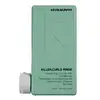What's inside
What's inside
 Key Ingredients
Key Ingredients

 Benefits
Benefits

 Concerns
Concerns

 Ingredients Side-by-side
Ingredients Side-by-side

Water
Skin ConditioningCetearyl Alcohol
EmollientCapryloyl Glycerin/Sebacic Acid Copolymer
Skin ConditioningDiheptyl Succinate
EmollientBehentrimonium Methosulfate
Glycerin
HumectantAvena Sativa Kernel Extract
AbrasiveXanthan Gum
EmulsifyingPersea Gratissima Oil
Skin ConditioningHydroxyacetophenone
AntioxidantGuar Hydroxypropyltrimonium Chloride
Skin ConditioningCetrimonium Chloride
AntimicrobialPhenoxyethanol
PreservativePotassium Sorbate
PreservativeSodium Benzoate
MaskingCitric Acid
BufferingWater, Cetearyl Alcohol, Capryloyl Glycerin/Sebacic Acid Copolymer, Diheptyl Succinate, Behentrimonium Methosulfate, Glycerin, Avena Sativa Kernel Extract, Xanthan Gum, Persea Gratissima Oil, Hydroxyacetophenone, Guar Hydroxypropyltrimonium Chloride, Cetrimonium Chloride, Phenoxyethanol, Potassium Sorbate, Sodium Benzoate, Citric Acid
Water
Skin ConditioningSodium C14-16 Olefin Sulfonate
CleansingCocamidopropyl Betaine
CleansingLaureth-5 Carboxylic Acid
CleansingSodium Chloride
MaskingGlycerin
HumectantCaprylyl/Capryl Glucoside
CleansingParfum
MaskingSodium Hydroxide
BufferingCitric Acid
BufferingHexylene Glycol
EmulsifyingSodium Benzoate
MaskingPEG-55 Propylene Glycol Oleate
Propylene Glycol
HumectantAloe Barbadensis Leaf Juice Powder
Skin ConditioningSalicylic Acid
MaskingPolyquaternium-67
Benzoic Acid
MaskingBenzyl Alcohol
PerfumingCoumarin
PerfumingLinalool
PerfumingBenzyl Benzoate
AntimicrobialHexyl Cinnamal
PerfumingLimonene
PerfumingWater, Sodium C14-16 Olefin Sulfonate, Cocamidopropyl Betaine, Laureth-5 Carboxylic Acid, Sodium Chloride, Glycerin, Caprylyl/Capryl Glucoside, Parfum, Sodium Hydroxide, Citric Acid, Hexylene Glycol, Sodium Benzoate, PEG-55 Propylene Glycol Oleate, Propylene Glycol, Aloe Barbadensis Leaf Juice Powder, Salicylic Acid, Polyquaternium-67, Benzoic Acid, Benzyl Alcohol, Coumarin, Linalool, Benzyl Benzoate, Hexyl Cinnamal, Limonene
Ingredients Explained
These ingredients are found in both products.
Ingredients higher up in an ingredient list are typically present in a larger amount.
Citric Acid is an alpha hydroxy acid (AHA) naturally found in citrus fruits like oranges, lemons, and limes.
Like other AHAs, citric acid can exfoliate skin by breaking down the bonds that hold dead skin cells together. This helps reveal smoother and brighter skin underneath.
However, this exfoliating effect only happens at high concentrations (20%) which can be hard to find in cosmetic products.
Due to this, citric acid is usually included in small amounts as a pH adjuster. This helps keep products slightly more acidic and compatible with skin's natural pH.
In skincare formulas, citric acid can:
While it can provide some skin benefits, research shows lactic acid and glycolic acid are generally more effective and less irritating exfoliants.
Most citric acid used in skincare today is made by fermenting sugars (usually from molasses). This synthetic version is identical to the natural citrus form but easier to stabilize and use in formulations.
Read more about some other popular AHA's here:
Learn more about Citric AcidGlycerin is already naturally found in your skin. It helps moisturize and protect your skin.
A study from 2016 found glycerin to be more effective as a humectant than AHAs and hyaluronic acid.
As a humectant, it helps the skin stay hydrated by pulling moisture to your skin. The low molecular weight of glycerin allows it to pull moisture into the deeper layers of your skin.
Hydrated skin improves your skin barrier; Your skin barrier helps protect against irritants and bacteria.
Glycerin has also been found to have antimicrobial and antiviral properties. Due to these properties, glycerin is often used in wound and burn treatments.
In cosmetics, glycerin is usually derived from plants such as soybean or palm. However, it can also be sourced from animals, such as tallow or animal fat.
This ingredient is organic, colorless, odorless, and non-toxic.
Glycerin is the name for this ingredient in American English. British English uses Glycerol/Glycerine.
Learn more about GlycerinSodium Benzoate is a preservative. It's used in both cosmetic and food products to inhibit the growth of mold and bacteria. It is typically produced synthetically.
Both the US FDA and EU Health Committee have approved the use of sodium benzoate. In the US, levels of 0.1% (of the total product) are allowed.
Sodium benzoate works as a preservative by inhibiting the growth of bacteria inside of cells. It prevents the cell from fermenting a type of sugar using an enzyme called phosphofructokinase.
It is the salt of benzoic acid. Foods containing sodium benzoate include soda, salad dressings, condiments, fruit juices, wines, and snack foods.
Studies for using ascorbic acid and sodium benzoate in cosmetics are lacking, especially in skincare routines with multiple steps.
We always recommend speaking with a professional, such as a dermatologist, if you have any concerns.
Learn more about Sodium BenzoateWater. It's the most common cosmetic ingredient of all. You'll usually see it at the top of ingredient lists, meaning that it makes up the largest part of the product.
So why is it so popular? Water most often acts as a solvent - this means that it helps dissolve other ingredients into the formulation.
You'll also recognize water as that liquid we all need to stay alive. If you see this, drink a glass of water. Stay hydrated!
Learn more about Water